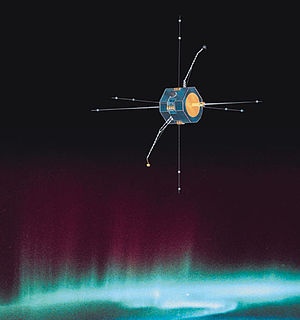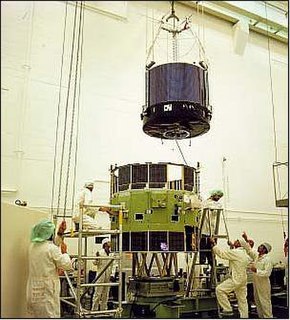
IMAGE is a NASA Medium Explorer mission that studied the global response of the Earth's magnetosphere to changes in the solar wind. It was believed lost but as of August 2018 might be recoverable. It was launched 25 March 2000, at 20:34:43.929 UTC, by a Delta II launch vehicle from Vandenberg Air Force Base on a two-year mission. Almost six years later, it unexpectedly ceased operations in December 2005 during its extended mission and was declared lost. The spacecraft was part of NASA's Sun-Earth Connections Program, and its data has been used in over 400 research articles published in peer-reviewed journals. It had special cameras that provided various breakthroughs in understanding the dynamics of plasma around the Earth. The principal investigator was Jim Burch of the Southwest Research Institute.

The Global Geospace Science (GGS) Wind satellite is a NASA science spacecraft launched on 1 November 1994, at 09:31:00 UTC, from launch pad LC-17B at Cape Canaveral Air Force Station (CCAFS) in Merritt Island, Florida, aboard a McDonnell Douglas Delta II 7925-10 rocket. Wind was designed and manufactured by Martin Marietta Astro Space Division in East Windsor Township, New Jersey. The satellite is a spin-stabilized cylindrical satellite with a diameter of 2.4 m and a height of 1.8 m.

The Fast Auroral SnapshoT Explorer was a NASA plasma physics satellite, and was the second spacecraft in the Small Explorer program (SMEX). It was launched on 21 August 1996, from Vandenberg Air Force Base aboard a Pegasus XL launch vehicle. The spacecraft was designed and built by NASA's Goddard Space Flight Center (GSFC). Flight operations were handled by GSFC for the first three years, and thereafter were transferred to the University of California, Berkeley's Space Sciences Laboratory.

The Solar Anomalous and Magnetospheric Particle Explorer was a NASA solar and magnetospheric observatory, and was the first spacecraft in the Small Explorer program. It was launched into low Earth orbit on 3 July 1992, from Vandenberg Air Force Base aboard a Scout G-1 launch vehicle. SAMPEX was an international collaboration between NASA and the Max Planck Institute for Extraterrestrial Physics of Germany. The Solar Anomalous and Magnetospheric Particle Explorer (SAMPEX) is the first of a series of spacecraft that was launched under the Small Explorer (SMEX) program for low cost spacecraft.

Explorer 54, also called as AE-D, was a NASA scientific satellite belonging to series Atmosphere Explorer, being launched on 6 October 1975 from Vandenberg Air Force Base board a Thor-Delta 2910 launch vehicle.

Explorer 18, also called IMP-A, IMP-1, Interplanetary Monitoring Platform-1 and S-74, was a NASA satellite launched as part of the Explorer program. Explorer 18 was launched on 27 November 1963 from Cape Canaveral Air Force Station (CCAFS), Florida, with a Thor-Delta C launch vehicle. Explorer 18 was the first satellite of the Interplanetary Monitoring Platform (IMP). Explorer 21 (IMP-B) launched in October 1964 and Explorer 28 (IMP-C) launched in May 1965 also used the same general spacecraft design.

Energetic Neutral Atom (ENA) imaging, often described as "seeing with atoms", is a technology used to create global images of otherwise invisible phenomena in the magnetospheres of planets and throughout the heliosphere.

Explorer 14, also called EPE-B or Energetic Particles Explorer-B, was a NASA spacecraft instrumented to measure cosmic-ray particles, trapped particles, solar wind protons, and magnetospheric and interplanetary magnetic fields. It was the second of the S-3 series of spacecraft, which also included Explorer 12, 14, 15, and 26. It was launched on 2 October 1962, aboard a Thor-Delta launch vehicle.

The ISEE-1 was an Explorer-class mother spacecraft, International Sun-Earth Explorer-1, was part of the mother/daughter/heliocentric mission. ISEE-1 was a 340.2 kg (750 lb) space probe used to study magnetic fields near the Earth. ISEE-1 was a spin-stabilized spacecraft and based on the design of the prior IMP series of spacecraft. ISEE-1 and ISEE-2 were launched on 22 October 1977, and they re-entered on 26 September 1987.

The ISEE-2 was an Explorer-class daughter spacecraft, International Sun-Earth Explorer-2, was part of the mother/daughter/heliocentric mission. ISEE-2 was a 165.78 kg (365.5 lb) space probe used to study magnetic fields near the Earth. ISEE-2 was a spin-stabilized spacecraft and based on the design of the prior IMP series of spacecraft. ISEE-1 and ISEE-2 were launched on 22 October 1977, and they re-entered on 26 September 1987.

Explorer 21, also called IMP-B, IMP-2 and Interplanetary Monitoring Platform-2, was a NASA satellite launched as part of Explorer program. Explorer 21 was launched on 4 October 1964, at 03:45:00 GMT from Cape Canaveral (CCAFS), Florida, with a Thor-Delta C launch vehicle. Explorer 21 was the second satellite of the Interplanetary Monitoring Platform, and used the same general design as its predecessor, Explorer 18 (IMP-A), launched the previous year, in October 1964. The following Explorer 28 (IMP-C), launched in May 1965, also used a similar design.

Explorer 41, also called as IMP-G and IMP-5, was a NASA satellite launched as part of Explorer program. Explorer 41 as launched on 21 June 1969 on Vandenberg AFB, California, with a Thor-Delta E1 launch vehicle. Explorer 41 was the seventh satellite launched as part of the overall Interplanetary Monitoring Platform series, though it received the post-launch designation "IMP-5" because two previous flights had used the "AIMP" designation instead. It was preceded by the second of those flights, Explorer 35, launched in July 1967. Its predecessor in the strict IMP series of launches was Explorer 34, launched in May 1967, which shared a similar design to Explorer 41. The next launch was of an IMP satellite was Explorer 43 in 1971.

Explorer 43, also called as IMP-I and IMP-6, was a NASA satellite launched as part of Explorer program. Explorer 43 was launched on 13 March 1971 from Cape Canaveral Air Force Station (CCAFS), with a Thor-Delta M6 launch vehicle. Explorer 43 was the sixth satellite of the Interplanetary Monitoring Platform.

Explorer 45 was a NASA satellite launched as part of Explorer program. Explorer 45 was the only one to be released from the program Small Scientific Satellite.

Explorer 47, was a NASA satellite launched as part of Explorer program. Explorer 47 was launched on 23 September 1972 from Cape Canaveral, Florida, with a Thor-Delta 1604. Explorer 47 was the ninth overall launch of the Interplanetary Monitoring Platform series, but received the launch designation "IMP-7" because two previous "Anchored IMP" flights had used "AIMP" instead.

Explorer 50, also known as IMP-J or IMP-8, was a NASA satellite launched to study the magnetosphere. It was the eighth and last in a series of the Interplanetary Monitoring Platform.

Dynamics Explorer 1 was a NASA high-altitude mission, launched on 3 August 1981, and terminated on 28 February 1991. It consisted of two satellites, DE-1 and DE-2, whose purpose was to investigate the interactions between plasmas in the magnetosphere and those in the ionosphere. The two satellites were launched together into polar coplanar orbits, which allowed them to simultaneously observe the upper and lower parts of the atmosphere.

Dynamics Explorer 2 was a NASA low-altitude mission, launched on 3 August 1981. It consisted of two satellites, DE-1 and DE-2, whose purpose was to investigate the interactions between plasmas in the magnetosphere and those in the ionosphere. The two satellites were launched together into polar coplanar orbits, which allowed them to simultaneously observe the upper and lower parts of the atmosphere.
AMPTE-IRM, also called as AMPTE-Ion Release Module, was a Germany satellite designed and tasked to study the magnetosphere of Earth, being launched as part of the Explorer program. The AMPTE mission was designed to study the access of solar wind ions to the magnetosphere, the convective-diffusive transport and energization of magnetospheric particles, and the interactions of plasmas in space.
AMPTE-UKS, also called as AMPTE-United Kingdom Subsatellite, was a United Kingdom satellite designed and tasked to study the magnetosphere of Earth, being launched as part of the Explorer program. The AMPTE mission was designed to study the access of solar wind ions to the magnetosphere, the convective-diffusive transport and energization of magnetospheric particles, and the interactions of plasmas in space.


















